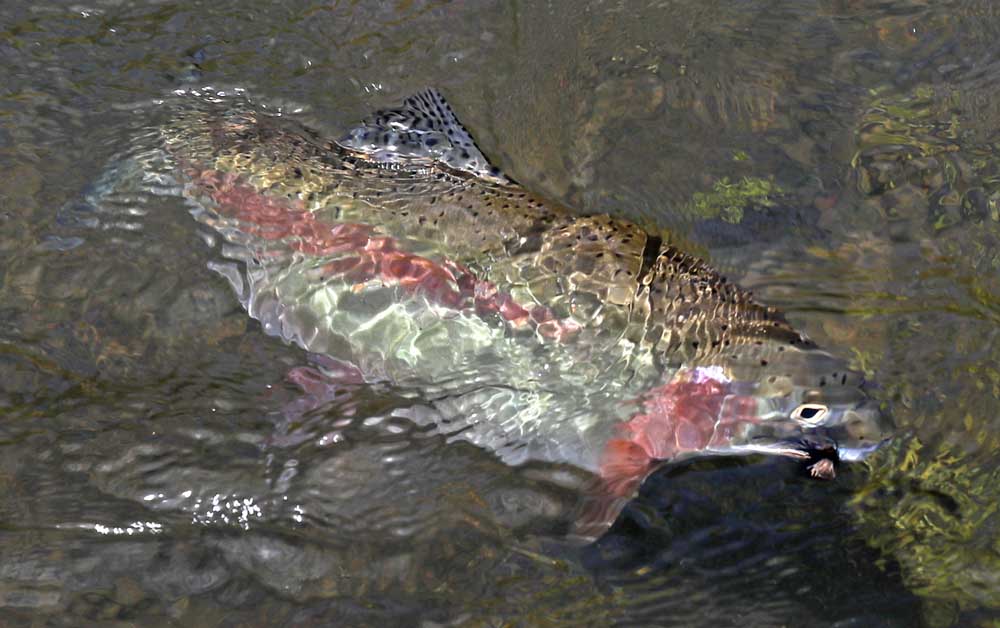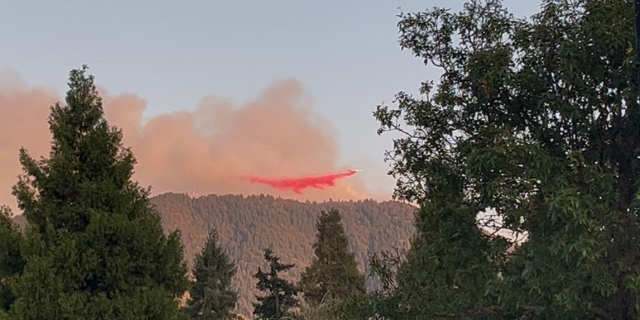They’re big and ugly: Annual salmonfly hatch attracts fish, fishermen
Published 6:00 am Saturday, June 17, 2023

- A rainbow trout fell for a salmonfly imitation on the Holy Water section of the Rogue River Wednesday.
A Rogue River tradition is underway with the annual salmonfly hatch attracting fly fishermen from near and far to the “holy water” just below the William L. Jess Dam at Lost Creek Lake.
Trending
On Wednesday, the flies were abundant, the fish were jumping and old friends got together.
“It’s a beautiful place,” said Larry Rupp of Cache Valley, Utah, who was in town to visit his adult son, Brigham Rupp of Medford. “My son guaranteed a beautiful place where you could stand in the water and wave your arm.”
The classic image of a fly fisherman is an angler in waders, standing in the water, fly rod in hand, casting about in something of a waving motion.
Trending
“Catching a fish was a pure bonus,” Rupp said.
Salmonflies are the biggest of the stoneflies, up to 3 inches long. They emerge about the same time each year around Memorial Day and live as adults for a few weeks to mate, lay eggs and, on occasion, get eaten.
They’re big and ugly, and fish love them. Anglers do, too, as bait. Imitation flies are made to resemble the real thing — part of the fly-fishing strategy to “match the hatch.”
The holy water — to be revered — is a stretch of river about half a mile long between the dam and the Cole M. Rivers Fish Hatchery, about 30 miles northeast of Medford. Anglers there must use barbless hooks and release any catches.
Trout are abundant there. A couple of riverside parks are nearby. The dam looms high.
Larry Rupp, his son and buddy Allen Grunig of Cache Valley had been out since about 8:30 a.m. and it took the elder Rupp until about 2 p.m. to land that bonus fish, which his son estimated at 12-14 inches.
“I think it was 2 feet,” Larry Rupp argued, though he lacked the evidence. “Thirty-six inches.”
“From 14 to 36 in about 40 seconds,” Grunig noted.
Larry Rupp learned to fish late in life. It was on his bucket list, and it was Grunig who taught him.
“It wasn’t tough,” Grunig said. “First time out, he got one on. That was all it took.”
“Now we’re fishing the Rogue River,” Larry Rupp said. “How cool is that?”
Anglers might have another week or so to get in on the action, while the fish are gorging themselves on the salmonflies, which don’t fly very well and often float on the water’s surface, flapping their wings, attracting attention and death.
Brigham Rupp said he learned to fish “from YouTube and the Ashland Fly Shop.”
“They gave me way more advice than I spent there,” he said. “I try to buy a few flies. Every time I go I pick their brain.”
“It’s a beautiful day,” he said. “I wish we were catching a little more. Can’t complain.”
A few hundred feet upstream from the Rupp party were three friends: Kerry Slussar of Spokane, Washington; John Cutillo of Grants Pass; and Don Sheridan of Scottsdale, Arizona.
“We all get together,” Slussar said. “I’ve known each of them 40 years-plus.”
They grew up together in Scottsdale, but life took them in different directions.
Sheridan, the one who stayed behind in the desert, “refuses to convert,” according to Slussar.
“The only fishing there is in the golf course ponds,” Sheridan said.
The weather had been chilly that morning.
“Not a whole lot going on,” Slussar said.
He was the only one of the three to make a catch.
“I got him to my hand and took the hook out of his mouth,” he said.
Any thoughts on the moment?
“Get out and enjoy the outdoors,” he said. “You hear that a lot, but it’s true.”
As they fished with little luck on the west bank of the river, an angler just arriving on the other side walked up, stepped out into the water in his waders, and landed himself a trophy trout on his first good cast.
“I was kind of pissed off about that,” Slussar said.
Fishing, like life, isn’t always fair.
Fishing nearby was Paul Cataldo of Ashland, who was out in waist-deep water casting a hand-tied fly that resembled a salmonfly. In a period of about 15 minutes, fish jumped near him no fewer than eight times. Nearby, water rushed down the spillway of the dam. An osprey flew overhead.
The scientific name for salmonfly is Pteronarcys californica. It’s larvae live for two to four years underwater before emerging, shedding skin and flying, according to a poster at the nearby McGregor Visitors Center, 580 Takelma Dr.
Adult salmonflies live only one to three weeks, enough time to find a mate, lay eggs and die.
Females fly low over the water, trying to lay eggs in the water, but they often land on the water and become easy, delicious prey.
The flies can be found in Oregon on the Deschutes River and on the upper Rogue River. On the Rogue, their range can stretch from upriver of Lost Creek Lake to downriver near Rogue-Elk Park, about three miles upstream of Shady Cove.
Alex Rodriguez of the Rogue Valley Anglers shop in Medford said the hatch this year had been going since at least May 25 and maybe earlier. He predicted that the fun should go on “at least another week or so, maybe two weeks.”
Native Americans used the hatch as something of a calendar, according to Rodriguez.
“To them, that was the start of the spring Chinook season,” he said.
Chinook, trout, steelhead, they all like the flies.
Tito Ruiz of the Ashland Fly Shop, Brigham Rupp’s favorite shop, talked up the annual feeding frenzy.
“It’s a great time right now,” he said. “The goldens (golden stoneflies) seem to be hitting. The salmonflies are going like crazy. Everything’s hitting pretty good.”
Golden stoneflies are a slightly smaller fly. Ruiz said the hatch should be going on “probably another week and a half.”
“Just the other day, the trout started reacting to the flies,” he said. “Their noses weren’t breaking the surface (before then). It’s just barely getting started.”









